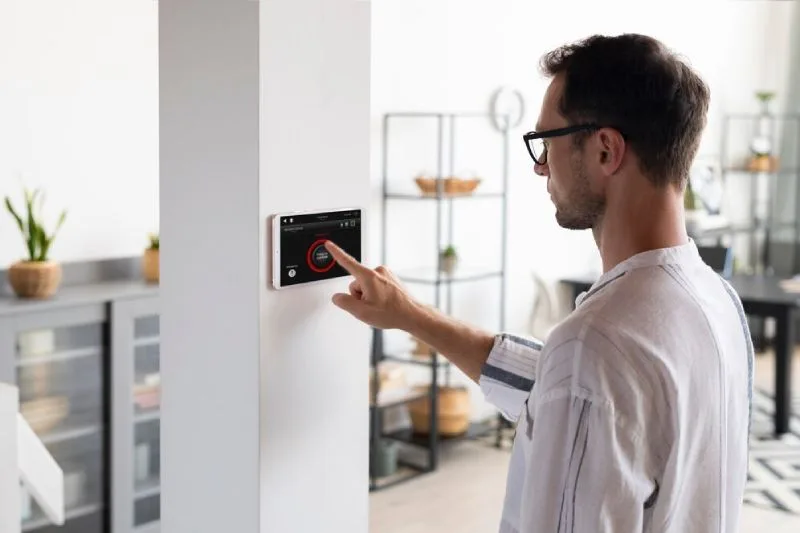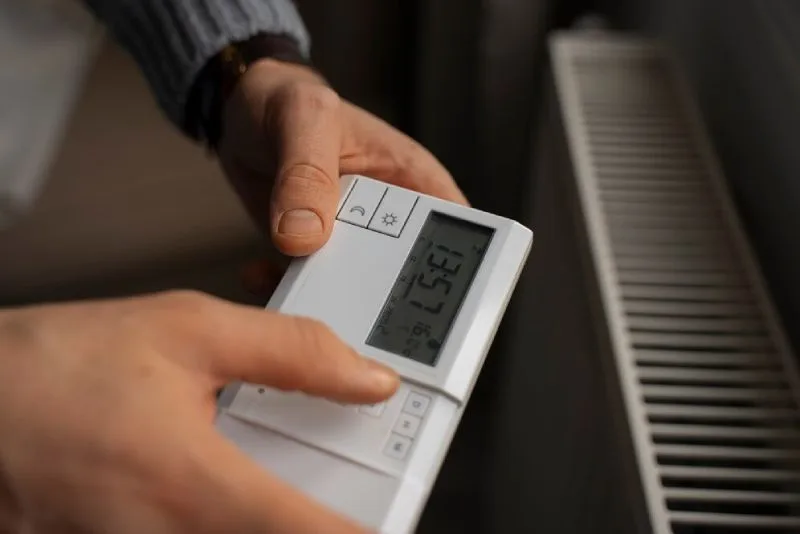Did you know you can save 10% of your yearly heating and cooling expenses using the right thermostat?
Your home needs thermostats to stay functional and comfortable. Choosing the right heat pump thermostat is crucial for optimizing your system’s performance, energy efficiency, and comfort. However, choosing a thermostat can be challenging, considering your specific needs, preferences, and budget.
In this guide, we’ll discuss key considerations and benefits and share expert tips to ensure your thermostat works harmoniously with your heat pump, providing you with ultimate comfort. Let’s get started!
Heat Pump Thermostats – How They Work!
When it comes to your home’s comfort, the thermostat in your heat pump system plays a pivotal role. It’s the conductor of your indoor symphony, regulating temperatures and ensuring your space is cozy in winter and cool during the scorching summer months. The temperature control begins when you set your desired temperature on the thermostat. Here’s why it matters:
- Accurate Temperature Sensing — A heat pump thermostat is your system’s eyes and ears, accurately sensing the indoor temperature. Precise readings are essential for your heat pump to determine when to switch between heating and cooling modes, optimizing energy efficiency.
- Efficiency & Comfort — A well-calibrated thermostat guarantees that your heat pump operates at its peak efficiency, saving you money on energy bills while maintaining a comfortable atmosphere.
- Climate Control — With programmable and smart heat pump thermostats, you can create customized schedules, ensuring your home is always the perfect temperature, whether you’re in or out.
Benefits of Installing Heat Pump Thermostat
Thanks to installing a smart heat pump thermostat, your heat pump system can now be controlled with precision. Accurate temperature sensing and smart control options are key to enjoying a cozy and cost-effective home year-round. Here are the key benefits you can expect:
- Energy Efficiency and Cost Savings — Smart heat pump thermostats learn your schedule and adapt, minimizing energy consumption. You can remotely adjust settings and set heating or cooling schedules to maximize efficiency and reduce monthly bills.
- Improved Comfort and Convenience — Enjoy personalized comfort with features like adjusting settings, ensuring your home is at the perfect temperature when you arrive.
- Environmental Impact and Sustainability — Minimize your carbon footprint by reducing energy waste. Some heat pump thermostats promote sustainable living and contribute to a greener planet.
- Remote Control and Monitoring — Whether you’re at work or on vacation, control your heat pump system from your smartphone. Monitor energy usage and receive alerts, putting the power of climate control in your hands.
Things You Need To Consider Before You Purchase a Heat Pump Thermostat
Investing in a thermostat helps enhance energy efficiency, greater comfort, eco-friendliness, and the ultimate convenience of climate control. Before purchasing a heat pump thermostat, consider crucial factors to ensure it meets your needs. Ensure it’s compatible with your heat pump model.
Pick a thermostat that complements your home’s decor for a seamless blend of function and style. You can also choose between programmable or non-programmable options based on your preferences.
Compatibility
Selecting the right thermostat is more than just temperature control—it’s about aligning with your needs, lifestyle, and budget. First, consider heat pump system compatibility with your home. Ensure the thermostat you choose complements your heating and cooling setup. Secondly, check the wiring compatibility to avoid any installation challenges. A well-matched thermostat ensures efficient operation tailored to your comfort needs while staying within your budget. It’s a decision that pays off in both comfort and savings.
Requirements for Wiring and Installation
When it comes to installing a new thermostat, understanding the wiring considerations can make the process smoother and prevent installation hiccups. Here are three crucial points to keep in mind:
- Existing Wiring Compatibility — Check if your current wiring is compatible with the new thermostat. Compatibility ensures a hassle-free installation.
- Labeling and Documentation — Before disconnecting any wires, label and document their placements to simplify reconnection.
- Professional Help — If unsure about the wiring or its compatibility, consider seeking professional installation to avoid complexity and ensure a successful setup.
Programmability
Programmable thermostats offer a world of convenience and energy savings, but to fully leverage their potential, it’s essential to grasp their features and customization options. Mastering these features and customizing your thermostat settings can lead to enhanced comfort, substantial energy savings, and reduced environmental impact.
- Temperature Scheduling — Create daily or weekly schedules to automatically adjust your home’s temperature based on your routine. This minimizes energy waste when you’re not home.
- Vacation Mode — Set your thermostat to vacation mode when you’re away, ensuring energy efficiency while maintaining safe indoor temperatures.
- Remote Control — Many programmable thermostats offer remote access via smartphones, allowing you to tweak settings on the go.
- Zoning — Some thermostats enable multi-zone control, letting you fine-tune temperatures in different areas of your home.
WiFi Accessibility
WiFi-enabled thermostats make daily life more convenient and promote energy savings, making them a valuable addition to any modern home. They are revolutionizing how we manage home comfort. With seamless remote control and smart home integration, they offer several benefits:
- Convenience — Adjust your thermostat remotely via smartphone or voice commands, ensuring your home is comfortable before you arrive.
- Energy Efficiency — Monitor and optimize your HVAC system, saving on energy costs by making real-time adjustments.
- Scheduling — Create customized heating and cooling schedules for different times of the day, enhancing comfort and efficiency.
- Integration — Sync your thermostat with smart home platforms, allowing for coordinated lighting control, security, and more.
Design and Aesthetics
When it comes to your home’s interior design, even the smallest details matter. By considering these factors, you can have a comfortable living environment and an interior that exudes your personal style. Here are three aesthetic considerations for thermostat placement that can seamlessly blend with your decor:
- Color and Style — Opt for a thermostat that complements your room’s color scheme and overall style. Some thermostats come in various finishes and designs to match your aesthetic preferences.
- Visibility vs. Discreetness — Decide whether you want your thermostat to be a focal point or discreetly tucked away. Some modern thermostats offer a sleek, unobtrusive appearance.
- Wall Placement — Ensure that your thermostat is installed at an appropriate height, ideally at eye level, for easy readability while not disrupting the balance of your room’s design.
Warranty and Price
When choosing a thermostat, it’s crucial to strike the perfect balance between price and features. Here’s why warranty coverage is a pivotal factor to consider:
- Peace of Mind — A robust warranty provides peace of mind, assuring you of product durability and support in case of issues.
- Long-Term Savings — Warranty coverage can save you money in the long run, preventing costly repairs or replacements.
- Product Quality — Manufacturers offering comprehensive warranties tend to stand behind their product’s quality, making it a safer investment.
Types of Heat Pump Thermostat
Selecting the right thermostat type is vital to match your specific comfort and lifestyle needs. Smart thermostats are perfect for tech-savvy individuals who value convenience and energy savings. Programmable thermostats are ideal for those with consistent routines, allowing temperature scheduling. Basic thermostats offer a budget-friendly solution for those who prefer manual control. Assess your requirements and choose the thermostat type that best suits your preferences, ensuring an optimal home climate and potential energy savings.
- Smart Thermostats — These high-tech wonders offer remote control and learning capabilities for energy-efficient and convenient climate control.
- Programmable Thermostats — Perfect for those who want to schedule temperature adjustments to match their daily routines.
- Basic Thermostats — Simple, manual control options that are budget-friendly. Choose the thermostat type that aligns with your lifestyle and comfort needs.

Heat Pump Thermostat FAQs
What is a heat pump thermostat?
A heat pump thermostat is a device that controls the heating and cooling functions of a heat pump system. It allows users to set and maintain desired indoor temperatures, ensuring the heat pump operates efficiently to provide heating and cooling in one system.
Does a heat pump need a special thermostat?
A heat pump does not necessarily require a special thermostat, but it’s recommended to use one designed for heat pumps. These thermostats are equipped to handle the unique operation of heat pumps, such as defrost cycles and reversing valve control.
What type of thermostat is used with the heat pump?
Thermostats used with heat pumps can vary but are typically categorized as basic, programmable, or smart. The choice depends on your preferences, budget, and desired level of control and automation.
Where is the thermostat for a heat pump?
The thermostat for a heat pump is typically located on an interior wall in a central area of your home. It’s usually placed where it can effectively sense the average temperature of the living space and make temperature adjustments accordingly.
How do I know if I have a heat pump thermostat?
You can determine if you have a heat pump thermostat by checking your HVAC system. If you have a heat pump, it’s likely that your thermostat is compatible with it. However, you can consult your thermostat’s user manual or a professional HVAC technician to confirm its compatibility and suitability for your heat pump system.
Conclusion
Choosing the right thermostat for your heat pump is pivotal for optimizing your home’s heating and cooling efficiency. Whether it’s a basic, programmable, or smart thermostat, informed choices can lead to enhanced comfort, energy savings, and convenience. If you have any questions or need guidance on thermostat selection and installation, please contact us. We’re here to help you achieve the perfect climate control in your home.




